USS PUEBLO - ELECTRONICS FIT
GENERAL
Much has been written about the USS Pueblo, AGER-2, the American spy
ship captured by North Korea in 1968. The purpose of this web page
is to document, as much as possible, information on the ship's electronics
fit. If you, as the reader, can help with identification, please contact:
jerry.proc@sympatico.ca . A Wikipedia article on Pueblo's
history can be found here.
 |
| USS PUEBLO at her new berth on the Botong River,
Pyongyang, North Korea - taken on July 27, 2013. The pennant
GER-2, was painted that way just to confuse. AGER-2 means Auxiliary, General
Environmental Research, but the Pueblo was not taking water samples. It
was collecting signals intelligence. (Mark Edward Harris photo) |
RADIO FITTING
This is the layout of the main operations area.
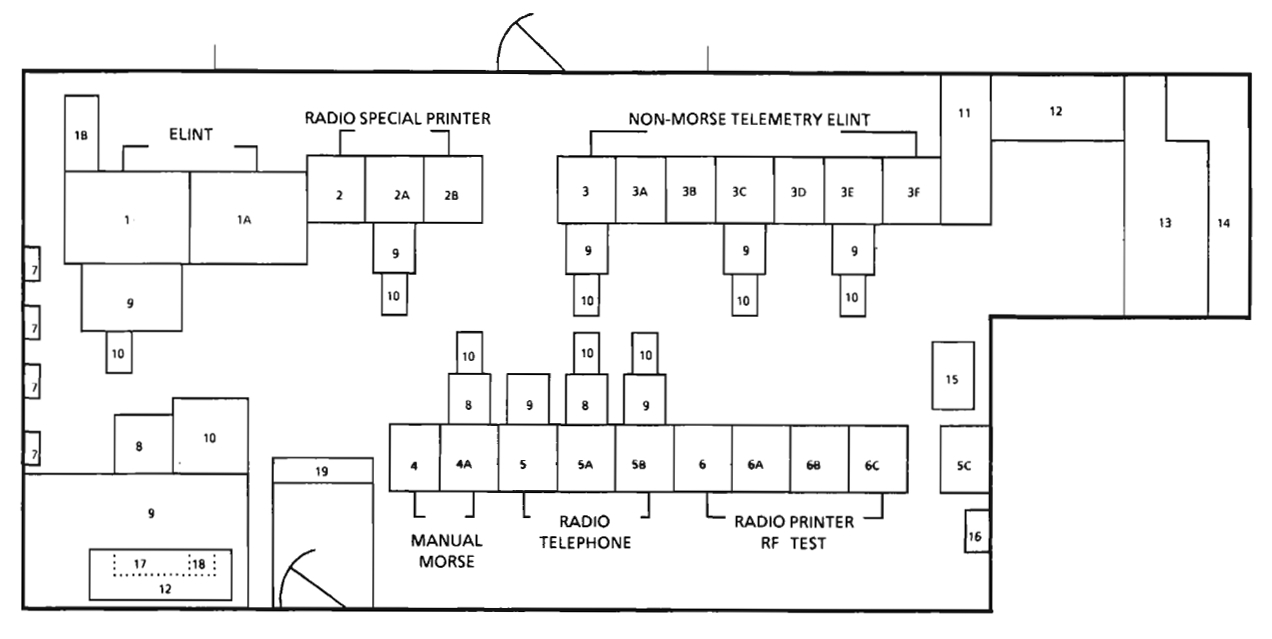 |
| This area was officially called the Special Operations Detachment,
aka as the SOD Hut. Download image to enlarge. (NSA image) |
The electronics in the SOD hut consisted of the following six positions.
Each of the positions has its own electronics manifest. Does anyone know
the detailed functions of each position? If so, contact: jerry.proc@sympatico.ca
Position 1 - ELINT
Position 2 - Radio Special
Printer
Position 3 - Non Morse Telemetry
ELINT
Position 4 - Manual Morse
Position 5 - Radio Telephone
Position 6 - Radio Printer Single Channel
and RF test.
THE SHIP'S ANTENNAS
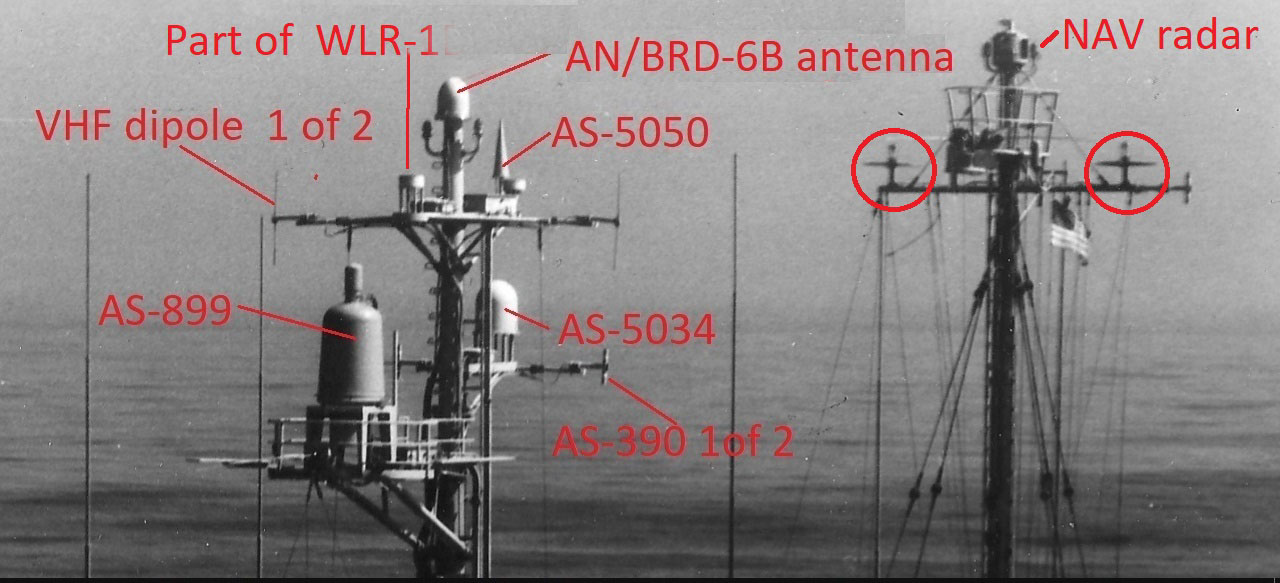 |
| These are the easiest antennas to identify on
the Pueblo. Click on image to enlarge.. The mast on the left is the foremast
while the one on the right side is the main mast. Atop the main mast is
the ship's navigation radar.
* AS-899, AS-5034, AS-5050 all belong with the AN/WLR-1 ECM receiver
* The circled antennas on the main mast are likely AS-5048 which are
part of the AN/WLR-1 receiver system.
* AS-390 are 200 to 400 MHz , UHF vertically polarized dipoles.
* VHF antennas are vertically polarized dipoles.
* There are 6 whip antennas fitted for the HF radios and likely some
wire antennas as well.
The current AS-899 antenna on the USS PUEBLO is a wooden mockup.
The original was removed by North Korea. |
 |
| It is believed that the AS-2814/SRC log periodic
antenna was used for VHF intercept. Some of the elements seem to
be missing. The cylindrical object in between the antenna and the
support mast is believed to be the motor which makes the antenna steerable.
(Part
of Wikipedia photo) |
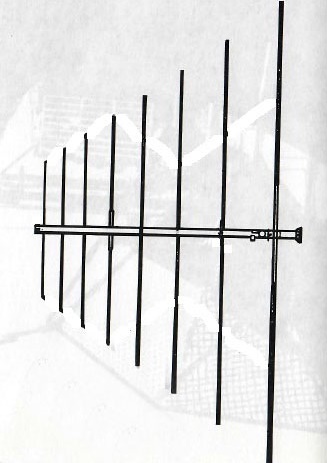 |
| Assuming that the AS-2814/SRC guess is correct, this is a
broadband, unidirectional, log periodic array. The antenna consists of
a main boom and eight active elements. It may be installed for operation
with either vertically or horizontally polarized signals and may be used
with any VHF transmitting or receiving equipment capable of operating within
its frequency range and RF power handling capabilities.
Frequency range: 30 to 76 MHz
Power rating: 100 watts
Impedance: 50 ohms.
Polarization: Either horizontal or vertical.
Dimensions: Height - 203 inches; Width - 116 inches.
Weight: 40 lbs.
Comments:
Vinyl jacketed mylar rope is supplied for use between the flexible radiating
elements to reduce vibration. Two AS-2814/SRC antennas are often
fitted on opposite sides of the ship, to obtain maximum coverage. Pueblo
only had one antenna.
Additional cross reference is the CHU Associates Model CA-3126 antenna.
Does anyone have an image of the 2814 antenna? If so, please contact :
jerry.proc@sympatico.ca . |
|
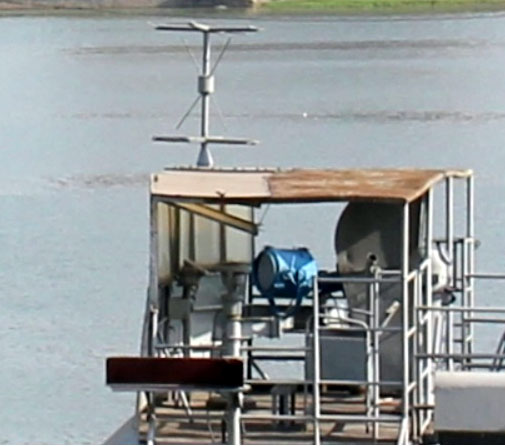 |
| AS-2512/SRC antenna atop Monkey's Island.
The elements are a bit hard to see in this image. (Part of Wikipedia
photo) |
 |
| The AS-2812 /SRC antenna is a small broadband,
omnidirectional vertical biconical dipole intended for shipboard and similar
applications where a rugged, reliable design is necessary. All major components
of the radiating and support structures are aluminum. A central feed section
is protected and weatherproofed by a laminated fiberglass cover. AS-2812/SRC
may be used with any UHF transmitting or receiving equipment designed to
operate within its frequency range and RF power handling limitations.
Frequency range: 200 to 1300 MHz
Dimensions: Height: 24 inches; Diameter: 15.75 inches;
RF power rating: 250 watts.
Polarization: Vertical
(Image courtesy Shipborne Antennas) |
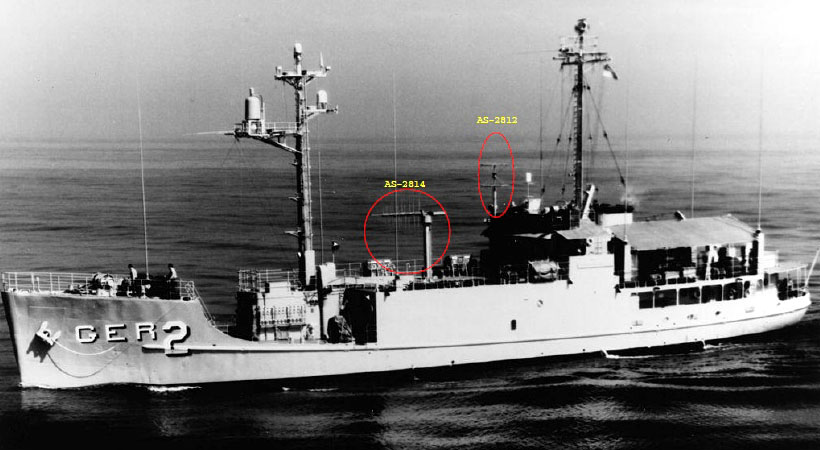 |
| These are the locations aboard the ship
for the AS-2814 and AS- 2812 antennas. (Image courtesy Shipborne Antennas) |
The following positions had ancillary functions:
Position 7 - Power Panel
Position 8 - Typewriter
Position 9 - Desk
Position 10 - Chair
Position 11 - Test Equipment Stowage
Position 12 - Bookcase
Position 13 - Work Bench
Position 14 - Shelf
Position 15 - Ventilator
Position 16 - Escape Scuttle
Position 17 - Eico 869-6 and S-9903D Supervisors Position
Position 18 - Monitor Switch For Supervisor
Position 19 - Steps
CRYPTO GEAR
From an NSA Cryptologic Damage Assessment Report, the following crypto
systems were compromised as a result of the Pueblo being captured.
* KL-47
* KW7 (ORESTES)
* KWR-37 (JASON)
* KG-13 (PONTUS)
* KG-14 (CREON)
One KL-47 was used for on-line encryption.
Two KW7s were designated for on-line Teletype encryption.
(Any of) Three KWR37s were used to receive the Navy's operational intelligence
broadcast.
Four KG-13s were used in conjunction with the KWR-37s for receiving
fleet broadcasts. When the Pueblo was captured by the North Koreans
in 1968, the personnel didn't have time to destroy the installed units
As a result, a working model of the KG-13 fell into enemy hands. NSA quickly
designed a modification to the koken stage board to alter its operation
in order that the enemy didn't have an identical working model.
Although it doesn't appear on the NSA Damage Assessment Report, the
KG-13 (PONTUS) system was also compromised. This is what was taught
at the Crypto Instruction school in the 1989-1990 time frame. This event
was taught, not as much for history's sake, but to explain alterations
and modifications that were made to the KG-13 sub systems, to, once again
make the machine secure after the compromise.
Below is a sample of the non-cryp[to portion of the system
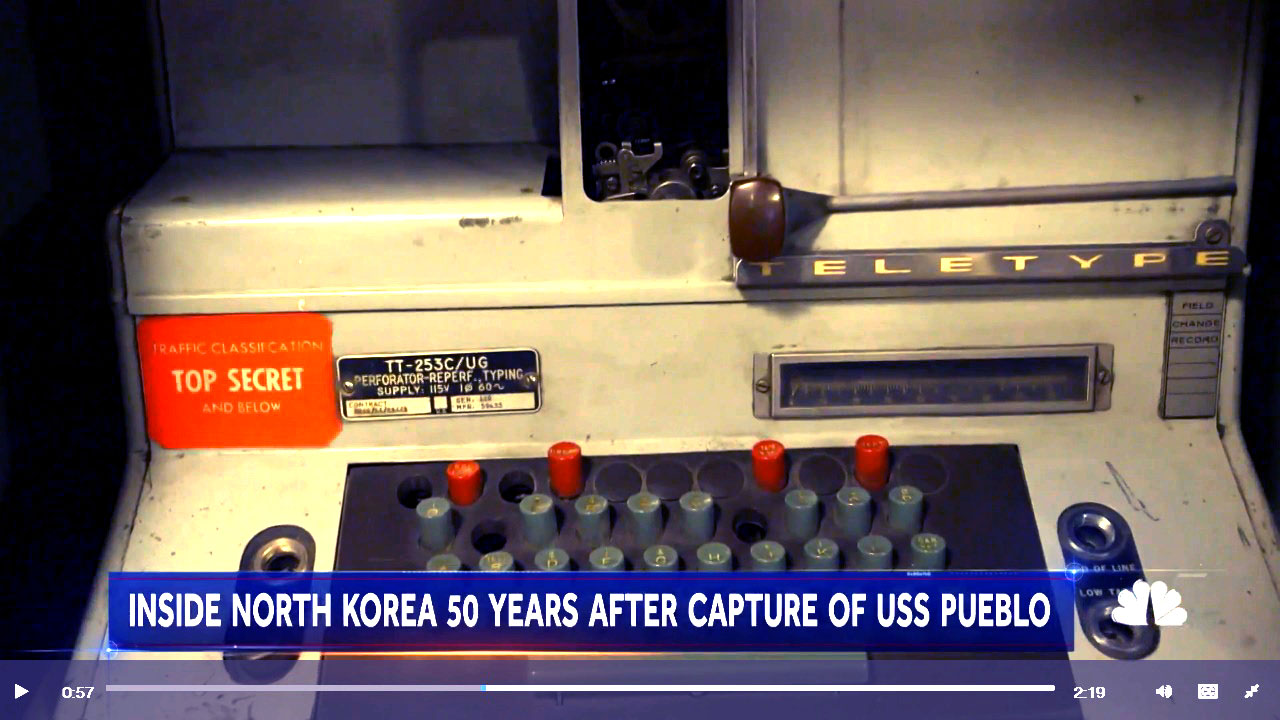 |
| This TT253 tape punch is not TOP SECRET. It means
that the device is attached to a circuit which has been authorized to handle
TOP SECRET traffic. (Image extracted from NBC News video) |
A complete copy of the Cryptologic
Assessment Report can be found here.
When the Pueblo was captured, there were still some 600 pounds
of documents which were not yet destroyed by the crew. This includded susch
items as parts lists, maintenance manuals, operations instruction, keylists
for Jan, Feb 1968 for five communications networks.
Classified cryptologic material was maintained in two areas aboard the
USS PUEBLO prior to the incident which led to her capture. These spaces
were:
(a) the Research Operations room, occupied by the Naval Security Group
Detachment, and
(b) the Administrative Office used by the Officer-in-charge.
Another Crypto Damage Assessment Report can
be found here.
SONAR/ACOUSTICS
A Washington Post article on the USS Pueblo , dated Jan 24, 1968 indicated
that Pueblo might have trailed a long line of microphones which could detect
underwater sounds. Jane's Fighting Ships (1968) confirms that the
Pueblo was equipped with "sonar equipment for submarine noise signature
identification.".
 jerry.proc@sympatico.ca
jerry.proc@sympatico.ca
Contributors and Credits:
1) Bill Streifer <bill.streifer(at)gmail.com>
2) Nick England <nick(at)navy-radio.com>
3) Cryptologic Damage Assessmet Report: WLR-
4) Robert Langille, President, EWCS
. ewcs(at)ewcs.ca
5) KG-13 Jerry Kemp
6) Ctyptologic Damafe Assessment Report https://nsarchive2.gwu.edu/NSAEBB/NSAEBB453/docs/doc25.pdf
7) :AS 2812 and AS 2814 antennas Shipborne Antennas.
2nd Edition . ISBN: 0-89006-123-8.
Author: Preston E. Law Jr.
Back to Page of Titles
Dec 26/23









 jerry.proc@sympatico.ca
jerry.proc@sympatico.ca